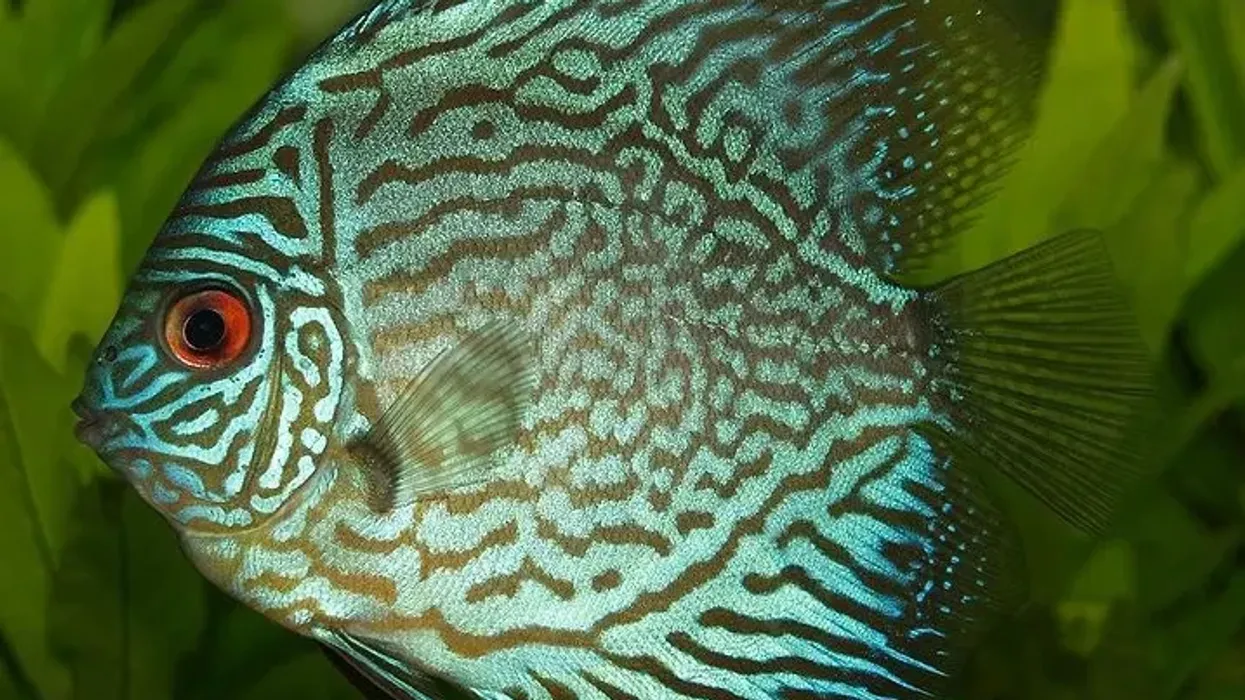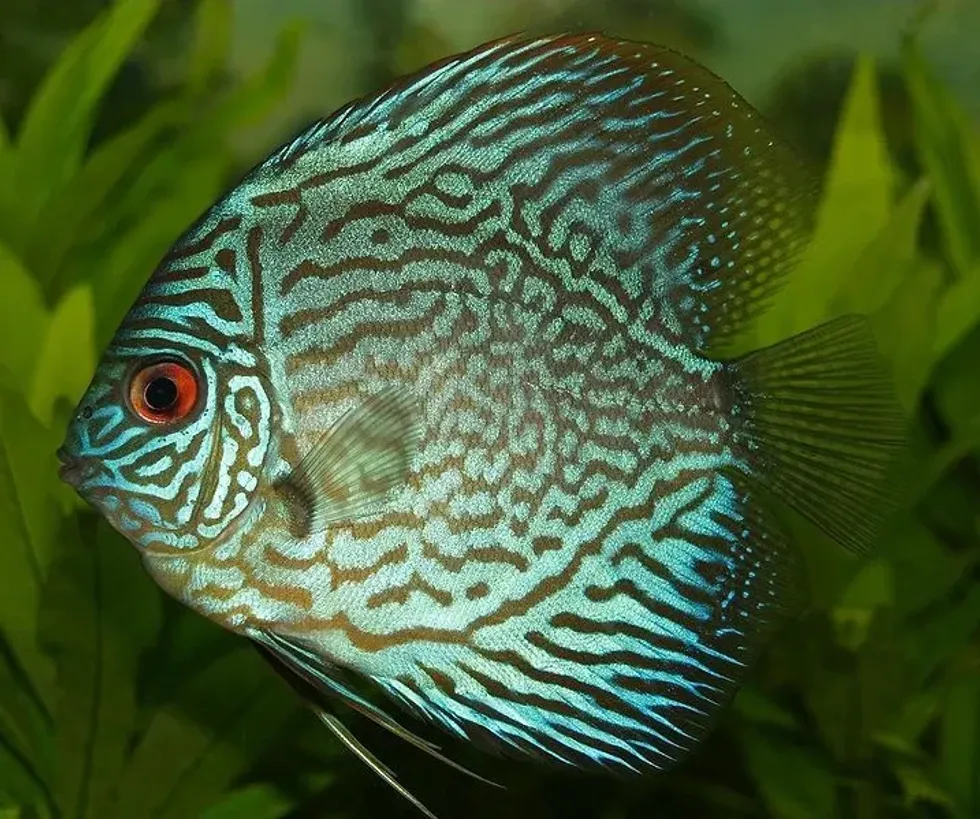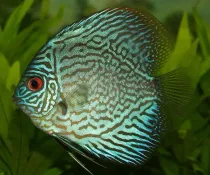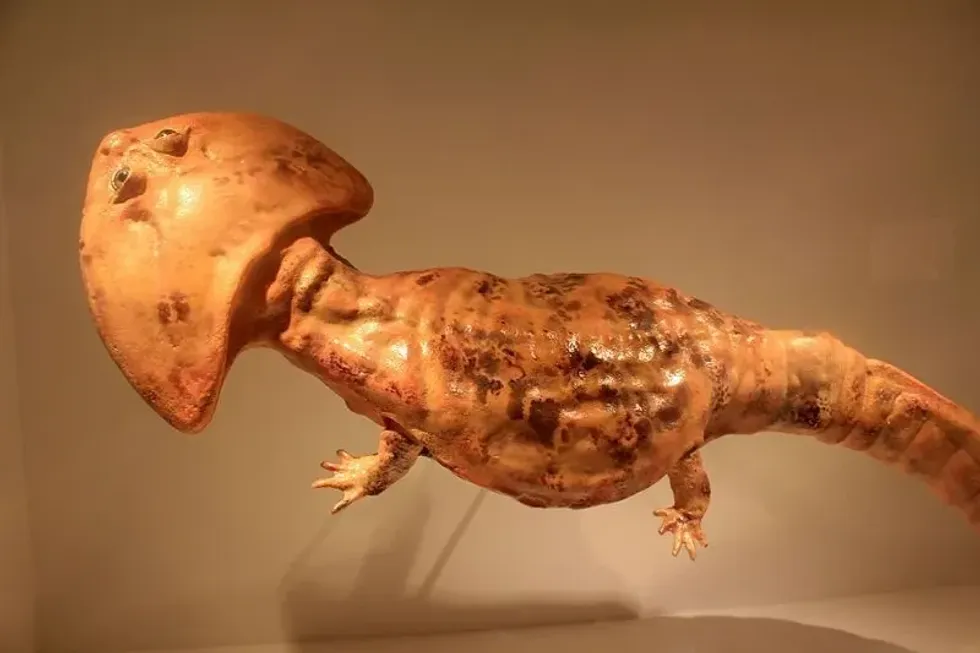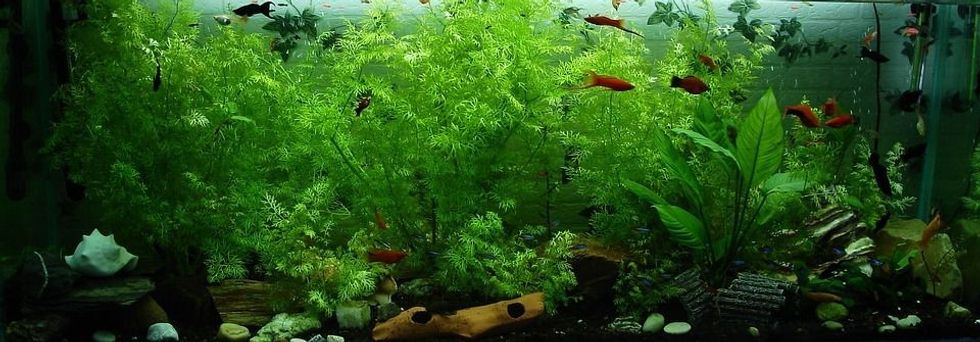Blue discus fish are members of the Cichlidae family, which is the largest group of freshwater fish including the cichlids and angelfish. The discus, in comparison to the angelfish and cichlids, prefers to live a stress-free life.
These fish are found in South America in the Amazon River Basin and due to their unique size and shape have turned into an amazing attraction in aquariums and community fish tanks all across the world.
These fish will add a vibrant touch to any aquarium due to the wide variety of colors they come in due to selective and cross-breeding!
However, these fish are not for beginners as they require a lot of love and attention, and will thrive in a clean environment. Blue discus, much like their other relatives, originates in shaded water with covers in the form of branches and other marine vegetation and prefers high-quality water.
Blue discus will act territorial during mating so it is usually recommended to separate them when you are breeding them.
If you liked these true facts about the blue discus, then you'll surely like these facts about ghost knifefish and royal gramma, too.
Blue Discus Interesting Facts
What type of animal is a blue discus?
A blue discus (Symphysodon aequifasciatus) is a famous freshwater fish that belongs to the species of cichlids. These fish are one of the highest quality and are known as the 'king of the aquarium fish'. Discus fish are most commonly found in the aquariums of hobbyists as they are great aquarium fish.
Discus fish are divided into three further main categories which include the Symphysodon aequifasciatus (blue and the brown discus fish), Symphysodon discus (red discus fish and the Heckel discus fish), and lastly, the Symphysodon tarzoo (green discus fish).
What class of animal does a blue discus belong to?
Blue discus (Symphysodon aequifasciatus) belong to the class of Actinopterygii as they are ray-finned fish. Actinopterygii is divided into two different classes Cladistia and Actinopteri. Actinopterygians comprise almost 30,000 species of fish including piranha and other species.
How many blue discuses are there in the world?
These peaceful fish are found abundantly in their habitat range due to abundant sources of foods like worms, smaller crustaceans, and plants.
These favorable conditions have helped keep the blue discus fish population at a stable rate as they are a species of fish that is not listed on the IUCN Red List, meaning they are in abundance in the wild.
Since the discus fish species is one of the most sought-after fish you can add to your aquarium, they are part of the fish trade and are bred by breeders, which adds to their stable population.
Where does a blue discus live?
The blue discus much like most of the discus fish are found around the Amazon River Basin. Some discus fish are also found in Southeast Asia.
Generally, even though they are found in the Amazon, they cannot survive in most regions where the flow of water is too fast or where the water is not clean enough. In the Amazon, these fish are found in tropical forests that have a long period of rainfall and will thrive in freshwater as they are freshwater fish.
What is a blue discus's habitat?
The blue discus fish prefer to live in the tropical rainforests of the flooded and lowland Amazon River Basin in South America and can be found in its tributaries like the Rio Negro.
These areas go through extreme changes in water level due to the seasonal flooding and these blue discus fish will congregate near fallen trees along the body of the water shore.
Blue discus fish prefer to live in a quiet water body among submerged tree roots, aquatic grasses, and dense vegetation.
The stripes on their body help these discus fish to hide from predators in the wild. These covers also serve as a breeding ground for these fish in their wild habitat range.
Who do blue discuses live with?
Unlike other members of the cichlid family, blue discus is generally a peaceful fish and shows highly social behavior. Blue discus fish are not predatory and will generally prefer to live in a group of around six other discus or other fish species.
Even in the wild, these discus fish are slow and docile. They can be kept in an aquarium or tank with other tropical fish that are peaceful and as they are slow feeders, they need companions that have a similar temperament.
How long does a blue discus live?
These freshwater fish have an average lifespan of 10 years, but proper care and a balanced diet with a good quality of food can increase their lifespan by up to five more years, taking their maximum lifespan to up to 15 years.
Like most aquarium fish, blue discus fish will eat almost anything, from frozen foods to flake food and worms, as this focused diet helps extend their life.
How do they reproduce?
Blue discus, just like the brown, green, and red discus fish, create nuclear families in the wild, but they are generally easy to breed in captivity. Female discus fish usually lay between 200-400 eggs that are fertilized by males.
Captive discus fish pair up and spawn easily, but the young inexperienced parents may end up eating the eggs the first few times of breeding, especially if other fish are present in the aquarium.
To breed a blue discus fish you will need to put lots of plants, rocks, and other ornaments in the aquarium as females will attach their egg batch to these ornamental decorations.
Spawning and rearing of babies can be done in hard water, but for fertilization and the development of the egg batch, total hardness of 6° dGH is recommended.
Since the blue discus fish prefer slightly acidic water quality, the pH of the water in their aquarium should be 5.5-6 with a temperature range between 82-88 F (28-31 C).
What is their conservation status?
Currently, the blue discus (Symphysodon aequifasciatus) alongside their relatives, the green and red discus fish, are not listed on the IUCN Red List. They are found in abundance in their native range of South America's Amazon River Basin water body.
Due to favorable temperatures and an abundance of food resources, these discus fish can be found in a large group all across rivers and lakes.
Also, since the discus fish is one of the most beautiful fish, it is a part of the global fish trade and is bred by breeders and pet stores. Cross-breeding has only helped in their popularity as these fish come in vast categories of colors and are a great addition to any aquarium or community fish tank.
Blue Discus Fun Facts
What do blue discuses look like?
Blue discus fish have a solid color body that ranges from yellow-brown to greenish-blue with anal and dorsal fins that have a deep iridescent blue or red color.
The royal blue variant of the blue discus fish has unique blue markings on their body and another one of the variants, the red royal blue discus has booth red and blue lines on their bodies.
The blue discus and other members of the discus family have the most flattened body of all the cichlids.

How cute are they?
Blue discus is one of the most beautiful fish that you can add to your aquarium. These fish are called the 'king of aquarium fish' due to their serene and calm nature as they can get along with other fish species from all across the world.
How do they communicate?
Like all other species of fish, discus fish also communicate through gesture, motion, and with a variety of chemically-induced methods.
How big is a blue discus?
Discus fish are small in size even though they are known as the 'king of the aquarium'. These fish grow up to 6 in (15 cm) in the wild, but in captivity, they can grow up to 10 in (25 cm).
How fast can a blue discus swim?
Unfortunately, the exact speed at which these fish swim cannot be stated due to a lack of recorded data, and most of the time, these species of discus prefer to swim slowly in a relaxed state.
How much does a blue discus weigh?
The blue discus is a lightweight fish with an average adult weighing between 5-9 oz (150-260 g).
What are the male and female names of the species?
There is no specific name for either sex of the discus fish.
What would you call a baby blue discus?
A baby blue discus, like most other baby fish, is called a fry.
After hatching, the fry will feed on the mucus that the parents secrete for a few days until the fry are big enough to free-swim. It is often recommended to remove the fry from the aquarium as inexperienced parents might end up eating the fry.
What do they eat?
The blue discus is omnivorous in nature and has a diet that consists of plant materials and worms and small crustaceans. In captivity, they will accept all sorts of foods like shrimp pellets, tropical flakes, frozen foods.
Are they aggressive?
No, blue discus is known as one of the most docile fish that can be introduced into an aquarium as they get along with other fish easily.
Would they make a good pet?
Yes, these fish are a great addition to any aquarium or community fish tank. Since these blue discus – much like the brown, green, and red discus – are peaceful in nature, they will get along with all other fish that you have in your aquarium!
Did you know...
Due to the popularity of these fish, there is a lot of artificial breeding which has resulted in a variety of colors like turquoise, green, white, and golden. These fish can also grow from between 3-10 in (8-25 cm), making them a unique addition to step up your setup.
Males and females stay together as couples as the discus prefer a slightly acidic water tone during breeding. The young are fed nourishment from the skin of the parent fish.
As discus requires very clean water, having a proper filtration system in your aquarium is a must to extend the lifespan of your discus.
If you are playing the popular video game 'Stardew Valley' and are looking for a spot to catch the blue discus, then you can catch them in any pond or river on Ginger Island!
In case you have a blue diamond discus and see its skin turning black, the reason behind this can be several.
This sudden color change can either be due to stress, the struggle of adapting to the new environment, bacterial infection, parasites, black stripe syndrome caused by protozoa, or simply because you have been sold a new species called the marble discus.
In case it is caused by illness, it is recommended to quarantine them and to give them medication with at least 50% water change and adding aquarium salt.
How did the blue discus get its name?
The blue discus along with the other brown, green, and red discus got their name from the name of their body. Austrian zoologist, Jakob Heckel, assigned the discus with the scientific name 'Symphysodon discus' as these fish resemble a discus that is used in the sport of discus throw.
Keeping blue discus
You can easily acquire a blue discus from any pet stores, breeders, or specialty dealers and their price can range from $18-150 depending on the size! Even though they are more readily available due to their popularity, they are still relatively expensive fish.
However, these fish are not for novice aquarists, so you should generally have an idea of what you are doing. Apart from that, these fish are easy to take care of and require minimal conditions like a minimum 50-gal (189 l) tank with slightly acidic water and water temperature that should be within 80-90 F (26.7-32 C).
However, the temperature must be 82-88 F (28-31 C) for breeding and the water movement in the aquarium should be moderate.
Blue discus should be kept in a group of at least six individuals to prevent them from dying from loneliness as they are extremely social fish and in case you are breeding them, the young should be separated from the adults as many fish parents end up eating their fry.
Since these fish are extremely social, it is recommended to keep semi-aggressive or aggressive categories of fish species like angelfishes and catfish away from them as there might be instances of their fins being bit by the aggressive catfish.
It is recommended that they should be kept with either their own species like the green discus and the turquoise discus or with other species like the neon tetra, congo tetra, and glowlight tetra.
Here at Kidadl, we have carefully created lots of interesting family-friendly animal facts for everyone to discover! For more relatable content, check out these mandarinfish facts and lambchop rasbora facts pages.
You can even occupy yourself at home by coloring in one of our free printable Blue discus coloring pages.

